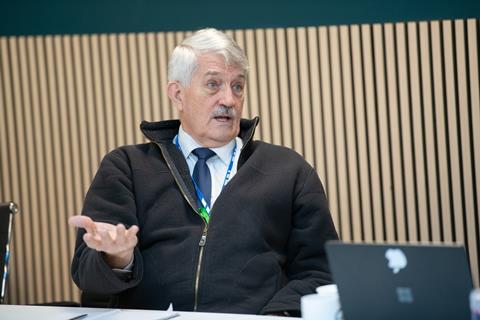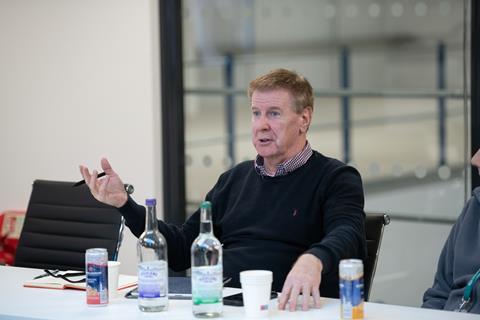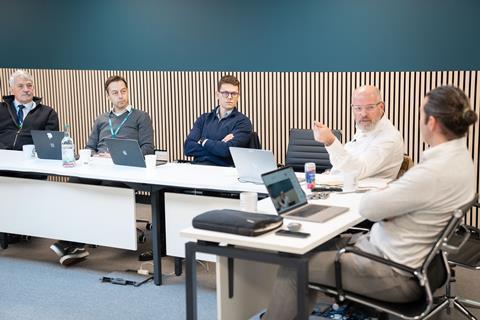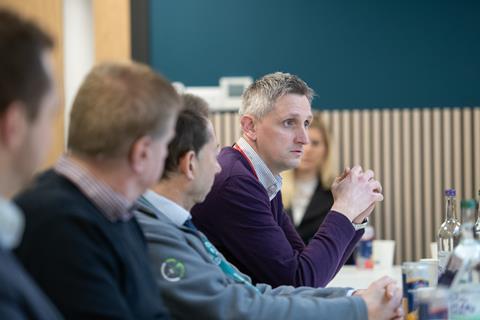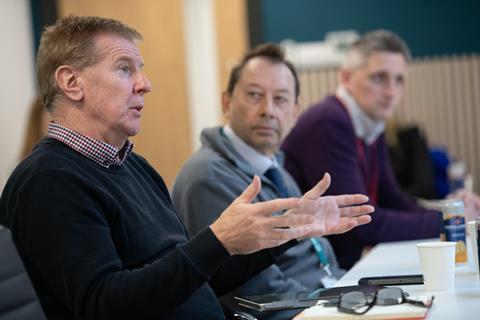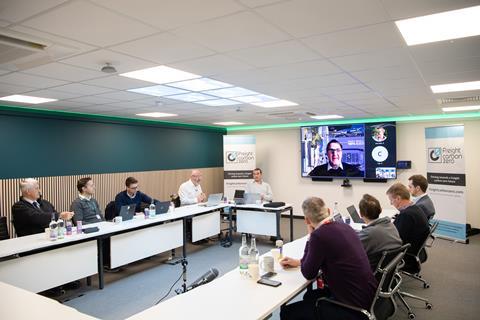The Electric Freightway project is part of the government-funded ZEHID (Zero Emission HGV and Infrastructure Demonstrator) programme and is well advanced in its project planning and development, with the first vehicles hitting the road in May 2024. We headed to project lead GRIDSERVE’s Swindon innovation centre for a roundtable of industry stakeholders to review progress and get an update on the project.
“The ultimate hypothesis for this project is to establish if electric, maximum weight HGVs are ready to replace diesels and can deliver the same functionality when the right infrastructure is in place.”
That’s Sam Clarke, Chief Vehicle Officer at GRIDSERVE, and one of the leaders of the Electric Freightway project, giving an initial overview on project progress and getting our round table under way. “Of course, we hope to prove the hypothesis is correct, but it’s important to underline, we’re open to challenge and will be learning and developing as we progress.”
As regular Freight Carbon Zero readers will know, our major concern with the ZEHID programme, was that it would be so focused on advocating the solution, that the learnings and pinch points of the implementation of zero- emission vehicles, crucial to the industry’s transition, would be lost. It was refreshing, therefore, to hear this is a fundamental mission of the project and judging by our initial encounter with the group, this will be a very important aspect of the programme.
Funded by the Department for Transport and delivered in partnership with Innovate UK, Electric Freightway aims to lay the foundations for the biggest and most advanced electric Heavy Goods Vehicle (eHGV) charging network in the world. With £62.7m in funding, an estimated 140 trucks to go on the road, 200 high power chargers to be located across 30 sites and 14 commercial vehicle operators on-board to run the trucks, it’s clear Electric Freightway is well advanced. “I can tell you after six months, we already know how difficult and challenging this project is going to be,” says Clarke, “but we are well prepared to take on the challenges and explore solutions.
“We’ve got three OEM partners on-board [DAF, Renault Trucks and Volvo],” he continues, “which may expand as time moves on. Our leasing partners are secured and we have discussions with a number of landowners for the infrastructure locations. Indeed, we’ve got a factory up in Sunderland, where we’re looking to place chargers for use by a number of operators.”
Charging challenges
Arguably the most important part of the ZEHID programme is the focus on energy and infrastructure, indeed the same goes for all discussions about the journey to net zero in our experience, and it didn’t take long for the roundtable discussion to hone in on this area.
“The first question we’re asking consortium members is how fast do they need to charge?”
John Whybrow, eHGV Programme Director, GRIDSERVE
“There is a huge difference between the amount of power required to charge six vehicles overnight versus six vehicles that need to double-shift and therefore only have a narrow window to recharge,” explains John Whybrow. “The power requirements of the latter often requires a substation to support, which adds cost, time and complexity. The sooner District Network Operators (DNOs) can understand where the loads are going to be, the earlier they can factor these into their future energy scenarios.”

Peter White is Energy Systems Engineer at National Grid and has a career of experience from the energy sector. He echoed Whybrow’s early engagement mantra: “The earlier you can engage with the host DNO, put all your cards on the table and say, ‘by such and such a date, I want so many MVAs (mega volt amperes)’, the better. Then the host DNO knows where the goalposts are and can start planning,” he told the group. “We can then introduce things like ramp capacity, work with you and build a solution to match the needs.”
“A lot of the work that we’re undertaking on the infrastructure is to understand exactly which sites we can do in the timeframe available,” confirmed Clarke. “A lot of that is predicated on what grid connections we’ve already got or applied for.”
Engagement is one thing, but many of the early engagers Freight Carbon Zero and Motor Transport are hearing from are reporting very long waiting times for grid connections, explained the roundtable facilitator Andy Salter. Is that real? He asked the group.
“It all depends on what you want,” White explained. “If your grid connection requires a substation connection, for example, then that might already be in the plan, for other connections it could be longer.”
Tim Campbell, Director at Campbell Consultancy, spends a lot of time working with companies who are on the decarbonisation journey. “As you’ve heard, there are lots of variables at play, it depends on what you want to do, where you are located and the timescales you are working to,” he said. “There needs to be early engagement to establish some facts about what’s possible and then the real planning can begin.”
The Electric Freightway project has a remit to deliver publicly available charging stations, and returning to Whybrow’s initial request for data to drive the energy capacity requirements the group offered some insights: “At a granular level, that should be relatively straightforward for a fleet operator if they have got tracking or telematics on the vehicle. This should give them the relevant information,” said White. “There are data analysts in the industry who can look at the telematics data for their fleet and build a model for switching their vehicles.
“On a macro level ACEA (the European trade association for the vehicle manufacturers, equivalent to the UK’s SMMT) released 500,000 vehicle’s worth of telematics data for vehicles in Europe in 2019. This data shows where the vehicles stop, though we don’t have information for how many vehicles stop at the locations in a 24-hour period. If we could work that out, we can calculate the MVA requirements for any particular site and build this into the planning. I know the data is for fossil-fuelled trucks, but it’s not a bad proxy for the energy requirements.”
This data and analysis is essential in order to get the grid upgraded to the required level, with the added complexity of ensuring the energy is in the right place to deliver the expected charging solutions, White added.
Electric Freightway expects motorway service areas (MSAs) will be the most likely location for the public chargers and GRIDSERVE has a lot of experience in this area having established passenger car chargers at more than 180 locations, including the vast majority of MSAs: “Our only issue with MSAs is that they are already heavily oversubscribed with the volume of trucks,” explains Clarke. “So there’s a few challenges in terms of how we get the power in the right place and whether we need more space.”
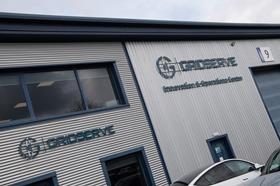
White also reckoned getting the power to the MSAs may prove challenging: “Historically MSAs have only needed relatively low levels of energy for their equipment,” he explained. “If you’ve now got 400 battery electric trucks stopping there in the future, my back of a fag packet calculation would indicate you’re going to need a town’s worth of electric to charge them and, in many cases, they are not in the most convenient places. We’ve got to put the infrastructure in there and that doesn’t take five minutes.”
Booking system
Assuming the power grid will catch up and the network of chargers begins to take shape, the Electric Freightway team is already spying the next looming challenge. To ensure maximum optimisation of chargers, while securing the availability of working charge points, will require some technical intervention, says the project team. Anyone driving a battery electric car will be aware of the need for planning to maximise range availability. The need for some form of digital platform to manage that supply and demand is a task on which the project team have already devoted much thinking time.
“We’ve done quite extensive research since we started on this project in June last year,” explains Whybrow, the lead on this initiative. “The booking system was a key part of what we put into the bid. We’ve found that there’s nothing out there that gets even gets close to the job that needs to be done, taking into account the complexity of the many factors.
“For instance, on the fixed trunking routes, the fleets know where the vehicles are, where they are going to be taking their breaks and for how long. They need to know a charger will be available at the time. For others, staying overnight for example, they will need a different charging solution. Any tool needs to reflect that, and more.”
“Currently, we have a question mark over charging during the driver’s rest period as this could be considered ‘other work’,” explained Campbell. “This needs clarifying and the law amending to allow for re-charging times being part of the driver rest period.”
“I think we’re probably into hundreds of hours of modelling scenarios on the bookability reservation planning,” continued Whybrow. “Our engineers are working on all the different scenarios that we need to consider. It’s not just about bookability, it’s about the time slots that we need, how far in advance can we allocate. How do you book? What are the cancellation terms? Can I defer my reservation if I get stuck in traffic? I’m so pleased we allocated budget to this in the project, as it would have been easy to overlook as it wasn’t actually part of the initial scope of the tender.”
Managing duty cycles
From charging and infrastructure, the conversation moved onto operational duty cycles and while most fleets, including the Royal Mail represented on the roundtable, are working on the basic assumption electric vehicles will replace diesel on a like- for- like basis, there’s a general acceptance this may need to be adapted as the learnings from the demonstration programme are surfaced.
“The current expectation is we’ll deliver the infrastructure to enable battery electric vehicles to replace diesel operational duty cycles,” explains James Comer, Programme Director at Hitachi, the principal partner on the project. “We’re seeing that is the case at the moment, but we are mindful that in the long term, there may need to be some operational transformation to decarbonise some of the more difficult routes.”
Stuart Murphy is the Head of Fleet Transformation and Integration at Royal Mail, one of the project partners and is very focused on transitioning away from his diesel fleet, but in a measured, planned way. “We’re doing a lot of work trying to assess the impact of putting double- deck trailers on battery electric vehicle operation,” he explained. “We need to understand whether the wind resistance of the tall trailers is going to have a disproportionate impact on vehicle range. Then trying to map this across our network to determine which vehicles are suitable on which routes. Our aim is to remove diesels. That’s the aim of this project.”
“This is a very important part of the equation,” explained Tim Campbell, “as well as focussing on the truck, it’s essential the trailer and bodybuilders don’t get left out of this discussion around battery electric vehicles. The use of lightweight aluminium and other composite materials, rather than steel, could have a big impact in offsetting some of the payload penalties that we associate with battery electric trucks.
“I think each truck manufacturer is different: what makes a good diesel manufacturer will not necessarily make a good electric vehicle manufacturer. This is a watershed moment for the industry in terms of re-evaluating all the normal assumptions.”
“We’ve got to understand and accept this is new to us all,” explained Murphy, “not just the fleet operators but also the OEMs.”
The truck manufacturers involved in Electric Freightway were represented on the call by Simon Calado at Renault Trucks and he gave the perspective from the vehicle builders: “We’re now working with over 14 million miles of data for vehicles currently being used across the whole of Europe,” he said, “so we’re learning a lot, very rapidly. We’re getting a huge amount of information on how the vehicles and the batteries are performing. This is extremely valuable as we develop the use cases and understand the operational capabilities of the vehicles.
“It takes time, to bring a product to market. The new product development gestation period can be anything up to around about seven years. We’re part of Volvo Group and so we are building our expertise across the business to deliver reliable solutions to our customers. We’ve been able to deploy our products much, much quicker than a lot of OEMs and have a full line-up of vehicles available to go to work.”
Collaboration is king…
A very clear highlight of the demonstration programme, thus far, is the efforts of the project team to pull so many different organisations together in a truly collaborative exercise. A very powerful signal that the industry is prepared to get on the journey to decarbonisation, despite the inevitable challenges ahead.
“I’m delighted we’re into double figures of trucks ordered through Electric Freightway even before we’ve put a charger in place,” explains Clarke. “Fleet operators have got the confidence to move forward. For some, it’s down to customer demand, others are keen to try the technology and know they’ve got sufficient power at their depots to charge overnight, and some just want to be part of the action.”
“The collaborative element of bringing together the parties has been the most beneficial aspect from our perspective as the report writer,” said Comer. “I’d love to sit here and say, we’re doing this because we’re all incredibly altruistic, and we want to see a better world for our kids. Of course, that is true, but there’s a commercial element to this, where it has to make financial sense, it has to be viable. Working through all of this will only come out of collaboration and that’s probably going to be one of the biggest takeaways from this programme.”
Summary
It shouldn’t come as any surprise, in the early stages of a project of this nature, that a roundtable on the topic will focus on the challenges. To do anything else and you’d accuse us of greenwash. The electrification of the commercial vehicle fleet in this country is a massive challenge, and it will need careful thought and consideration to navigate a path through.
As the Electric Freightway team said in our roundtable, the purpose of the demonstration programme is to tackle those pinch points head-on. Indeed, the need for speed across the projects is likely to artificially amplify those challenges, when in a few years’ time, a technological solution may render the concerns redundant.
Quite rightly, much of the current focus is on the development of the electricity grid and the network of chargers. Clearly, today, perceived demand is outstripping available supply and this has got many people worried, but we’d be surprised if the supply side doesn’t catch up, quickly. Similarly, the development of the booking tool to match available, working chargers with vehicles running on a tight schedule, looks like a fiendishly difficult task, but we’ve no doubt a model will emerge which cuts through and removes that as a barrier to development.
For us, the power of the demonstrations is to be alert to, and surface, those issues quickly so they can be tackled. Challenges to be overcome, rather than road blocks to halt progress. Some of these we already know about, and were discussed at the session, others are yet to be discovered.
It was refreshing to spend time with the knowledgeable project team to discuss these points in the roundtable and it’s clear the team has the skills and experience to deliver some very meaningful outputs.
We wish you luck, the industry needs you








